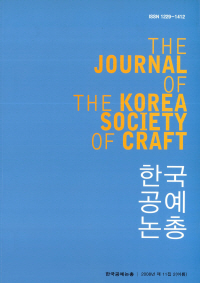- 영문명
- A STUDY OF ZHISHA CERAMICS IN CHINA
- 발행기관
- 한국조형디자인학회
- 저자명
- 우관호,(Woo, kwan-ho) 김유성(Kim, yoo-sung)
- 간행물 정보
- 『조형디자인연구』한국공예논총 제11집 2권, 1~23쪽, 전체 23쪽
- 주제분류
- 예술체육 > 미술
- 파일형태
- 발행일자
- 2008.06.30
5,560원
구매일시로부터 72시간 이내에 다운로드 가능합니다.
이 학술논문 정보는 (주)교보문고와 각 발행기관 사이에 저작물 이용 계약이 체결된 것으로, 교보문고를 통해 제공되고 있습니다.

국문 초록
영문 초록
Zhishahu is a small and very delicate type of tea-pot created in the Yixing province. These works are most often unglazed. These works originated during the Song Dynasty and were continually developed throughout the Yuan, Ming, and Qing Dynasties. They were not only used within China but were also considered export goods. During the 15th century, the artisans from the Seto Province travelled to Yixing to learn the techniques in creating Zhishahu. Later in the 17th century, the wares were exported to Europe along with tea under the name, "Red Porcelain." Eventually, in the early 20th century, Zhishahu received massive acclaim, both, in Europe and in the United States. Zhishahu was most prosperous during the Ming dynasty, specifically during the
Jiajing(1522-1566) and Wanri(1573-1620) era. It was this time the signature characteristics of the Zhishahu wares (extreme delicateness and color) were mastered. Zhishahu were prize possession of nobles, academics and poets throughout China. Futhermore, the academics and artisans would often collaborate in the design process to incorporate calligraphy and would create Zhishahu with various textural designs using tools made from bamboo.
The Qing Dynasty was considered the golden age of development for Zhishahu. There was a proliferation of artisans working towards developing the ware and the quality was dramatically increased. The type of clay used to the precision in design and function were nearly perfect. It was during this era that Zhishahu was accepted as a gift by the Royal Palace. The nobles of this era held high appreciation for Zhishahu, that the wares were
even placed in the ancient museum in Beijing and Taipei. During the Democratic period, Zhishahu continued in its traditional styles. The epigraphic surface designs that originated during the Qing Dynasty also prevailed during this time. It was during this time, Western studies and cultures influenced the East and production of the wares became more commercial. The workshops turned into businesses and signing of work was similar to that of branding. As a result of the needs of collectors, there was immediate success for those who began businesses in Shanghai, Tianjin and Hangzhou. There are four primary types of Zhishahu: Geometric, natural, muscle, and horizontal. The geometrical wares, which were called Guanghua, can further divided mainly into round and
square pots. There were variations such as cylindrical and hexahedron as well. The natural wares, which were called Huahua, which were considered to contain the artisan spirit, featured motifs which were made up of animals and plants. The muscle wares were melon in shape and often featured plants and flowers (chrysanthemum, narcissus, sunflower, etc) and were based on the geometric foundation of nature: proportion, division and duplication. The unique character of Zhishahu wares is based on the materials and the method of simultaneously ornamenting the piece while creating the base form. Also, the collaboration between artisans and writer, nobles, and merchants created unique and rare outcomes. The ornamental styles originated in the Ming and Qing Dynasties, particularly those methods used with porcelain, ivory, wood, stone, textures used in bronze-work, and special tombstone carving methods were skillfully fused in the production of Zhishahu. Methods of decoration
mainly consisted of carving, pinching, the decorative use of slip, stamping, on glaze, marbling, engraving, and other methods in craft.
목차
Ⅰ. 서 론
Ⅱ. 즈샤도(紫砂陶)의 태동과 변천
Ⅲ. 즈샤후의 원토와 종류
Ⅳ. 즈샤후의 분류, 구조, 장식
Ⅴ. 결 론
■ 참고문헌
해당간행물 수록 논문
참고문헌
관련논문
예술체육 > 미술분야 NEW
- 한국서비스디자인학회 2025년 춘계학술대회 목차
- 요식업 점주의 컨텍스트 정보 수집 및 예측을 통한 매장관리 서비스 - 배달 플랫폼을 중심으로
- AI를 통한 캐릭터 생성에 필요한 캐릭터의 Uniqueness 요소 분석에 관한 연구
최근 이용한 논문
교보eBook 첫 방문을 환영 합니다!

신규가입 혜택 지급이 완료 되었습니다.
바로 사용 가능한 교보e캐시 1,000원 (유효기간 7일)
지금 바로 교보eBook의 다양한 콘텐츠를 이용해 보세요!




